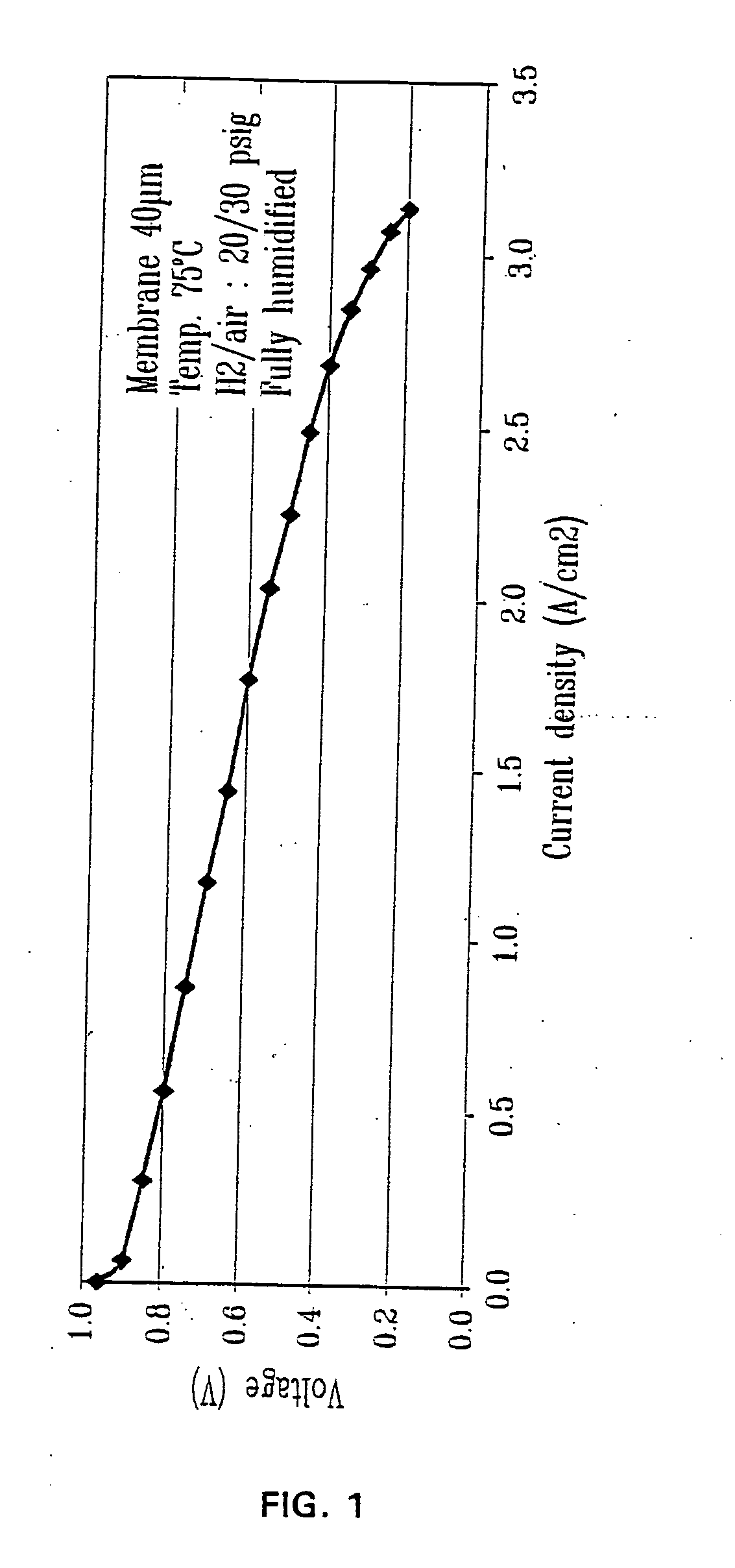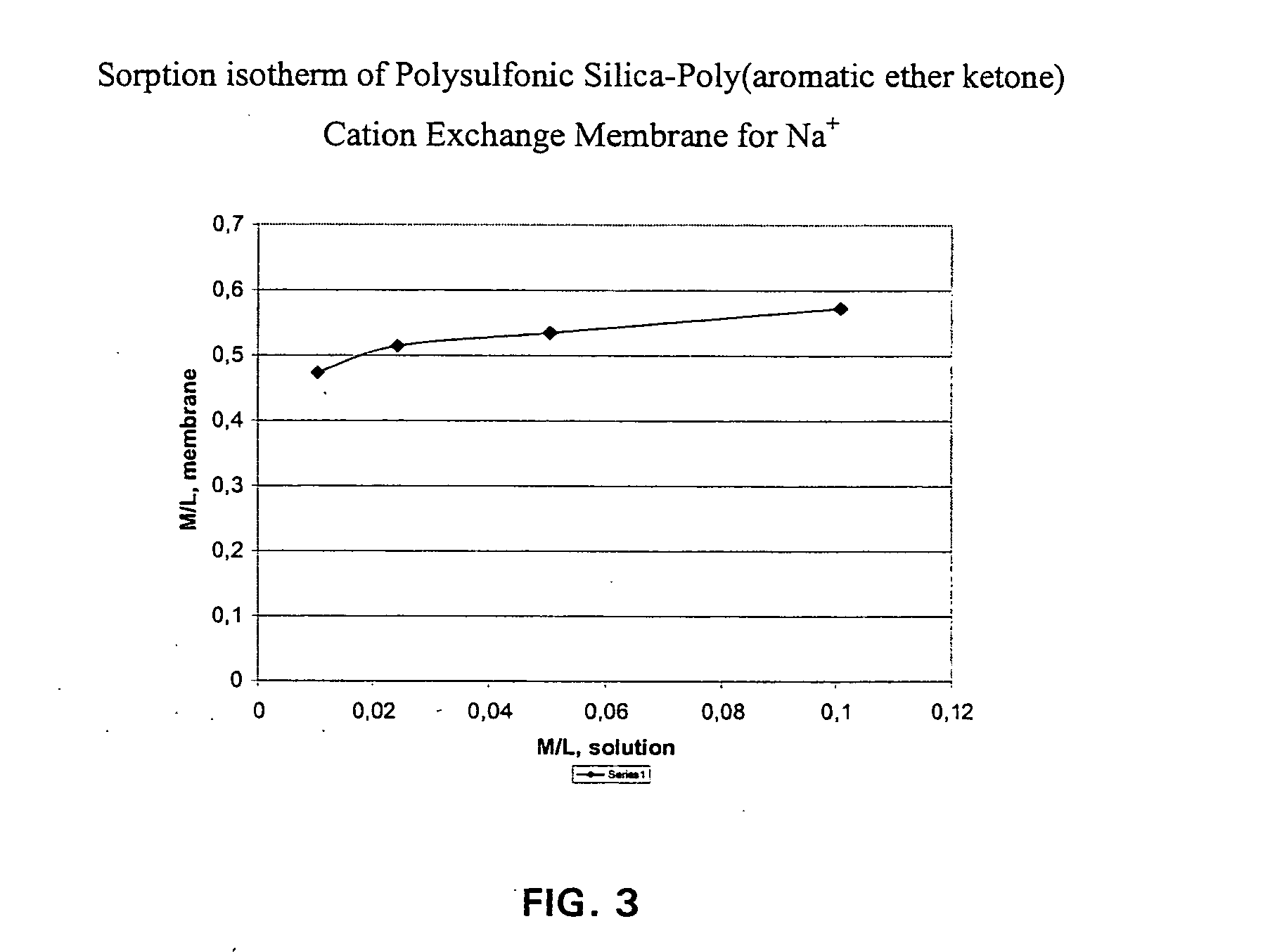Ion exchange composite material based on proton conductive functionalized inorganic support compounds in a polymer matrix
a proton conductive and functionalized technology, applied in the direction of diaphragms, electrical equipment, non-aqueous electrolytes, etc., can solve the problems of difficult to achieve, and difficult control of their preparations, etc., to achieve good water retention, good desalination effect, and good impermeability to gasses
- Summary
- Abstract
- Description
- Claims
- Application Information
AI Technical Summary
Benefits of technology
Problems solved by technology
Method used
Image
Examples
example 1
Sulfonation of PEEK
SPEEK with 55% of sulfonation is obtained, for example, by stirring 50 g of PEEK in 2 to 1 of H2SO4 (95-98% in H2O) for 48 hours at room temperature. The solution is poured in H2O and the solid phase, corresponding to sulfonated PEEK (SPEEK) is washed vigorously 2 to 3 times in 5:1 pure water. The isolated solid is first dried in an oven at about 70° C. for one night and then, after another washing, it is dried at 100° C. under vacuum for several days. About 40 g of SPEEK is obtained (yield ˜80%). Elementary analysis gives the sulfur content of the sulfonated polymer and the corresponding ion exchange capacity (IEC) is then calculated. An IEC of 1.6±0.1 mmol / g is obtained, corresponding to a sulfonation rate of about 55%.
example 2
Composite Film Preparation
a) 1 g of 55% sulfonated PEEK (SPEEK55) is solubilized in 10 ml of dimethylformamide (DMF) at room temperature and filtered on filter paper. A suspension of 0.2707 g of sulfonic acid grafted silica in 2 ml of DMF is added to the clear polymer solution. After stirring, the homogenous mixture is spread out over a 385 cm2 glass substrate before being dried at 70° C. for several days. After the complete evaporation of the solvent, the film is easily removed from the glass substrate by immersion in water. Once dried, the thickness of the composite film, made of 80% in weight of a 55% sulfonated PEEK and of 20% in weight of acid silica, is 40±10 μm.
b) 0.1755 g of SPEEK55 is solubilized in 1.7 ml of DMF and filtered. 0.0195 g of sulfonic acid grafted silica is added to the polymer solution. After homogenization, the mixture is spread out over a 25 cm2 glass substrate. Once dried, the composite film, comprising 90% in weight of a 55% sulfonated PEEK and 10% in ...
example 3
Electrode Deposition on Composite Films for Fuel Cell Testing
Commercial Pt / C electrodes (Pt / Vulcan XC-72 from ElectroChem Inc.) are stuck on composite films by spreading a small amount of SPEEK 55 10% DMF solution (w / v) on the side of the two electrodes that sandwich the membrane. Assemblies are dried under vacuum at room temperature for one day, under vacuum at 60° C. for one night, and at 80° C. for several days.
PUM
| Property | Measurement | Unit |
|---|---|---|
| current density | aaaaa | aaaaa |
| weight percent | aaaaa | aaaaa |
| weight percent | aaaaa | aaaaa |
Abstract
Description
Claims
Application Information
 Login to View More
Login to View More - R&D
- Intellectual Property
- Life Sciences
- Materials
- Tech Scout
- Unparalleled Data Quality
- Higher Quality Content
- 60% Fewer Hallucinations
Browse by: Latest US Patents, China's latest patents, Technical Efficacy Thesaurus, Application Domain, Technology Topic, Popular Technical Reports.
© 2025 PatSnap. All rights reserved.Legal|Privacy policy|Modern Slavery Act Transparency Statement|Sitemap|About US| Contact US: help@patsnap.com



